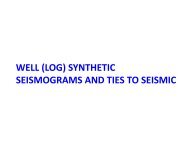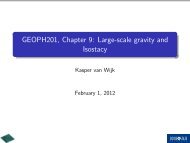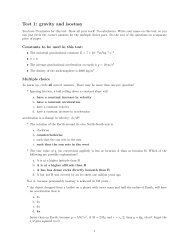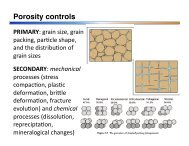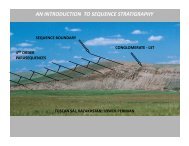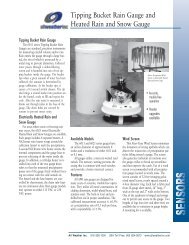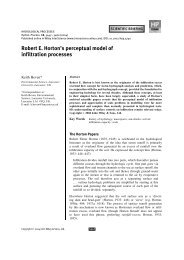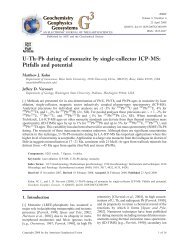Models of diffusion-limited uptake of trace elements in fossils and ...
Models of diffusion-limited uptake of trace elements in fossils and ...
Models of diffusion-limited uptake of trace elements in fossils and ...
You also want an ePaper? Increase the reach of your titles
YUMPU automatically turns print PDFs into web optimized ePapers that Google loves.
Trace element <strong>uptake</strong> <strong>in</strong> <strong>fossils</strong>? 3761<br />
<strong>in</strong>g DMD, faster <strong>diffusion</strong> rates have been documented for<br />
some <strong>elements</strong> <strong>in</strong> the near surface (outer few nm) <strong>of</strong> calcite<br />
crystals (Stipp et al., 1992). Because the bioapatite that<br />
composes <strong>fossils</strong> is nanocrystall<strong>in</strong>e, even after fossilization,<br />
relatively fast <strong>in</strong>tracrystall<strong>in</strong>e <strong>diffusion</strong> may permit DMD.<br />
Given sufficient time, all three models can expla<strong>in</strong> homogeneous<br />
compositions documented <strong>in</strong> some <strong>fossils</strong>, <strong>and</strong> all<br />
three processes might occur simultaneously. The central<br />
po<strong>in</strong>ts <strong>of</strong> the follow<strong>in</strong>g discussion are to demonstrate that<br />
(1) the exact fossilization process is irrelevant to dat<strong>in</strong>g<br />
problems, as long as boundaries were simple <strong>and</strong> <strong>trace</strong> element<br />
<strong>uptake</strong> was <strong>limited</strong> by <strong>diffusion</strong>, <strong>and</strong> (2) appropriate<br />
mathematical treatment <strong>of</strong> data simplifies <strong>in</strong>terpretation<br />
<strong>and</strong> error analysis.<br />
3.2. Mathematic treatment<br />
All solutions to the <strong>diffusion</strong> equation can be expressed<br />
<strong>in</strong> terms <strong>of</strong> the dimensionless variables reduced time (t 0 ) <strong>and</strong><br />
reduced distance squared (X 02 ). For this paper, t 0 = D eff t/l 2<br />
<strong>and</strong> X 0 = X/l, where D eff is the effective <strong>diffusion</strong> coefficient,<br />
t is time, l is the half-width <strong>of</strong> the tissue considered, <strong>and</strong> X is<br />
distance. Some workers prefer t 0 =[D eff t/l 2 ] 1/2 . The effective<br />
<strong>diffusion</strong> coefficient (D eff ) is the ratio <strong>of</strong> the <strong>trace</strong>r <strong>diffusion</strong><br />
rate (D) <strong>in</strong> a fluid <strong>and</strong> the partition coefficient between biogenic<br />
apatite <strong>and</strong> diagenetic or pedogenic fluids (K d ), corrected<br />
for porosity (r) <strong>and</strong> tortuosity (s), i.e., D eff = Dr/<br />
K d s 2 . Note that <strong>in</strong> applications discussed below D eff is a<br />
measured value, so it automatically accounts for contributions<br />
from porosity <strong>and</strong> tortuosity, <strong>and</strong> that K d , r, <strong>and</strong> s<br />
are presumed constant, so solutions to the <strong>diffusion</strong> equation<br />
scale equivalently with either D or D eff . If material diffuses<br />
from a s<strong>in</strong>gle (planar) boundary, e.g., from dent<strong>in</strong>e<br />
<strong>in</strong>to enamel across the dent<strong>in</strong>e–enamel <strong>in</strong>terface, <strong>and</strong>/or<br />
<strong>diffusion</strong> pr<strong>of</strong>iles are short (t 0 is small) then a semi-<strong>in</strong>f<strong>in</strong>ite<br />
solution is used, <strong>and</strong> X 0 is expressed as the distance from<br />
that surface or boundary (where X 0 = 0). In contrast, if<br />
material diffuses between 2 parallel <strong>in</strong>terfaces, e.g., <strong>in</strong>ward<br />
from both the <strong>in</strong>terior <strong>and</strong> exterior surfaces <strong>of</strong> cortical<br />
bone, then a plane sheet solution is used, <strong>and</strong> X 0 is expressed<br />
as the distance from the midpo<strong>in</strong>t between the<br />
two boundaries: X 0 = 0 is the center <strong>of</strong> the sheet, <strong>and</strong><br />
X 0 =1, 1 are the boundaries.<br />
Most models assume a fixed boundary condition, i.e.,<br />
that the concentration at any bound<strong>in</strong>g surface (C o ) is fixed<br />
at time t = 0. The <strong>in</strong>itial concentration <strong>of</strong> the diffus<strong>in</strong>g species<br />
(e.g., U, REE etc.) <strong>in</strong> the fossiliz<strong>in</strong>g tissue is also commonly<br />
assumed to be zero, <strong>and</strong> although this assumption is<br />
not required, it closely approximates biogenic compositions<br />
(e.g., see Driessens <strong>and</strong> Verbeeck, 1990; Kohn et al., 1999).<br />
Mathematically all models predict the change <strong>in</strong> <strong>trace</strong> element<br />
concentration (C), or its normalized concentration,<br />
(C 0 , where C 0 = C/C o ), as a function <strong>of</strong> reduced distance<br />
(X 0 ) <strong>and</strong> reduced time (t 0 ). Solutions to the <strong>diffusion</strong> equation<br />
were obta<strong>in</strong>ed from Crank (1975), specifically Eqs.<br />
3.13 (semi-<strong>in</strong>f<strong>in</strong>ite medium solution for model<strong>in</strong>g short <strong>diffusion</strong><br />
pr<strong>of</strong>iles <strong>in</strong> enamel), either 2.54 or 2.68 (plane sheet<br />
solutions for model<strong>in</strong>g long <strong>diffusion</strong> pr<strong>of</strong>iles <strong>in</strong> bone),<br />
<strong>and</strong> 13.13 plus 13.18 (semi-<strong>in</strong>f<strong>in</strong>ite medium solution for<br />
model<strong>in</strong>g DR).<br />
In this discussion, the term t 0 Dep is used to describe the<br />
time s<strong>in</strong>ce <strong>in</strong>itiation <strong>of</strong> the boundary condition <strong>and</strong> is equivalent<br />
to the total duration, or t 0 , <strong>of</strong> a model. In practice,<br />
t 0 Dep is proportional to the true depositional age, with a<br />
proportionality constant <strong>of</strong> D eff /l 2 . The term t 0 app is used<br />
to describe the apparent age at position X 0 with<strong>in</strong> a sample.<br />
In practice, t 0 app is proportional to the measured age with<br />
the same proportionality constant, D eff /l 2 .<br />
Examples for the DA plane sheet model show <strong>in</strong>creases<br />
<strong>in</strong> <strong>trace</strong> element concentration over time, with the rate <strong>of</strong><br />
<strong>in</strong>crease dependent on distance from the boundaries <strong>and</strong><br />
time (Fig. 2A). These concentration pr<strong>of</strong>iles must be converted<br />
to an age. For short <strong>diffusion</strong> pr<strong>of</strong>iles, e.g., REE <strong>in</strong><br />
enamel, this may be accomplished by fitt<strong>in</strong>g an <strong>in</strong>verse<br />
C/Co<br />
1.0<br />
0.8<br />
0.6<br />
0.4<br />
0.2<br />
X’=0.9<br />
X’=0.7<br />
X’=0.5<br />
X’=0.3<br />
X’=0.1<br />
t' app =<br />
t' True<br />
∫<br />
[ C/C o ]dt'<br />
t'=0<br />
t' Dep<br />
t'app<br />
1.0<br />
0.8<br />
0.6<br />
0.4<br />
0.2<br />
0.0<br />
0.0<br />
0.5<br />
0.0 0.2 0.4 0.6 0.8 1.0 0.0 0.2 0.4 0.6 0.8 1.0<br />
0.0 0.2 0.4 0.6 0.8 1.0<br />
t' Dep t' Dep Edge Distance<br />
X’=1.0<br />
X’=0.9<br />
X’=0.7<br />
X’=0.5<br />
X’=0.3<br />
X’=0.1<br />
Figure<br />
2C<br />
A B C<br />
t'app<br />
1.0<br />
0.9<br />
0.8<br />
0.7<br />
0.6<br />
1-X'<br />
1-X' 2<br />
t' Dep = 1.0<br />
Fig. 2. Numerical results <strong>of</strong> plane sheet DA model for U <strong>uptake</strong> over a range <strong>of</strong> timescales. (A) Concentration vs. time for different distances.<br />
Boundary is at X 0 = 1, <strong>and</strong> has constant composition C o throughout. Apparent age is determ<strong>in</strong>ed by <strong>in</strong>tegrat<strong>in</strong>g concentration curve (<strong>in</strong> terms<br />
<strong>of</strong> C/C o ) at a particular value <strong>of</strong> X 0 over duration t 0 Dep , <strong>and</strong> ratio<strong>in</strong>g to t0 Dep . (B) Apparent age ðt0 app Þ vs. depositional age ðt0 Dep<br />
, or age <strong>of</strong> <strong>in</strong>itial<br />
establishment <strong>of</strong> fixed boundary condition). At boundary (X 0 = 1) apparent <strong>and</strong> depositional ages co<strong>in</strong>cide, so the slope is 1. For long times,<br />
the slope <strong>of</strong> t 0 app<br />
for all positions approaches 1 as U is saturated. Circle shows <strong>in</strong>tegrated composition correspond<strong>in</strong>g to gray region <strong>in</strong> Fig. 2A.<br />
Box shows data po<strong>in</strong>ts plotted <strong>in</strong> Fig. 2C. (C) t 0 app<br />
vs. distance, show<strong>in</strong>g quadratic form with respect to distance, <strong>and</strong> l<strong>in</strong>earity with respect to<br />
distance squared. Note that any function that is l<strong>in</strong>ear <strong>in</strong> X 02 is also l<strong>in</strong>ear <strong>in</strong> 1 X 02 .<br />
Core



